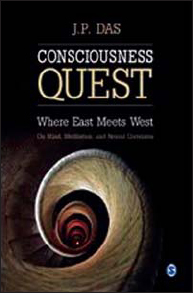Translate this page into:
Consciousness Quest: Where East meets West
Corresponding Author:
| How to cite this article: Patra B, Sharan P. Consciousness Quest: Where East meets West. Natl Med J India 2017;30:46-47 |
Consciousness Quest: Where east meets west. J.P. Das. Sage Publications, New Delhi, 2014. 308pp, ₹895. ISBN 978– 81– 321– 1349– 2.

Professor J.P. Das has a doctoral degree in psychology from the University of London, Institute of Psychiatry. He is Professor Emeritus of Educational Psychology and former Director of the Developmental Disabilities Centre at the University of Alberta, Edmonton in Canada. His research specializations include cognitive processes, neuropsychology and intelligence.
Consciousness is an area of both philosophical debates and scientific research. Consciousness quest focuses on a specific area where eastern contemplative traditions meet western empirical research. In this book both scientific thinking and research and philosophical views on consciousness have been explained.
In the Introduction, the author explains the first and third persons perspective of consciousness. He also addresses the explanatory gap between physical phenomenon and conscious experience, the subjective experience and objective existence of consciousness. Chapter 2 details the concept of consciousness in Indian and Buddhist philosophies. The steps of meditation for achieving the states of higher consciousness namely, dharana, dhyana and samadhi have been described and similarities and differences between samadhi and hypnosis have been elucidated. Many religious traditions describe mystical experience of consciousness. In mystical experience, the mind suddenly receives a divine message and attains the highest level of consciousness. This forms the basis for spiritual life. In chapter 4, the author summarizes the experience of some well-known mystics; and compares mystical experiences of consciousness with phenomenal and access consciousness.
Chapters 3, 5 and 6 dwell on the biological basis of consciousness, dream and waking; for example, data have been presented to highlight the possible role of transient hypofrontality in the state of reduced awareness during hypnosis or meditation. The author explains Hobson's three-dimensional models and Greenfield's concentric theory of consciousness. The role of neuronal gestalts, thalamo-cortico-thalamic circuit aided by pyramidal neurons and various neurotransmitters in consciousness have been detailed. In chapter 6, the author describes the findings on brain imaging during meditation and explains the effects of meditation on the autonomic nervous system, attention, perceptual habituation and emotion.
Chapters 7 and 8 describe mindfulness; its origin, its four noble truths and eight-fold procedure and its benefits in meditation practice. The western interpretations of mindfulness, neural and physiological changes due to practice of mindfulness and its application in clinical practice have also been explained. Chapter 9 details PASS (planning, attention, simultaneous and successive processing), a contemporary theory of intelligence and abhidhamma, a Buddhist model of cognition. Though both theories deal with consciousness, the central focus of PASS is cognitive/ intelligence, whereas consciousness is the only focus of abhidhamma.
In chapter 10, the author summarizes some recent western research on consciousness. Julian Janes’ concept of bicameral mind and Alwyn Scott's concept of physical world, psychological world and their interaction to form the self-conscious mind find a mention. Feinberg's nested hierarchy model and Edelman's group selection model to conceptualize consciousness are also mentioned, and compared to concepts of consciousness proposed by Luria. The chapter ends with the spiritual concept of consciousness as proposed by Tolle. In chapter 11, the western approach to consciousness has been compared with its eastern counterpart. Self-knowledge, access and sentience, the three contents of consciousness according to Pinker have been discussed.
The author mentions that according to Francis Crick, the anterior cingulated cortex is the seat of free will and has a role in cognitive control mechanism. He also discusses Gazzaniga's split-brain theory that explains the contribution of each hemisphere in consciousness. The author also discusses the views of two Indian thinkers—Krishnamurti and Sri Aurobindo. According to Krishnamurti, consciousness is unfragmented and is influenced by past and pre sent experiences and inherited factors. Sri Aurobindo proposed three levels of consciousness, i.e. the usually inaccessible subconscious state, the accessible conscious state and the timeless superconscious state; and the dynamic relation between the three states of consciousness.
Chapter 12 discusses the concept of consciousness from the materialistic point of view in eastern and western traditions. It starts with Charvaka's pure materialistic concept, which states that the self and consciousness have evolved from the material base of the body. Pavlov's experiment on conditioning, a theory of behaviourism and Vygotsky's concept of language as a pivot for shaping consciousness, are mentioned. Popper and Eccles’ model of interaction between physical, psychological and cultural world as constituting self-conscious mind is also described. Chapter 13 describes the subjective and objective aspects of consciousness from the eastern and western perspectives. In chapter 14, the author reviews the western concepts of basis of consciousness and describes Vygotsky's sociocultural basis of consciousness and Frith's concept of metacognition. The author concludes by narrating Pinker's ideas on possibilities to counteract the afflictive emotions such as violence by empathy, self-control and morality.
This book is intended for use by neuropsychiatrists and psychologists. The author successfully tries to weave eastern views and western research to understand the basis of consciousness. However, while explaining it from a neuroscientific perspective, consciousness seems to be reduced to ‘higher mental function’. The introduction provides an overview of all the chapters; and the end of each chapter provides a brief summary and discussion. These are helpful for the reader. The bibliography provided at the end of the book rather than at the end of each chapter, reduces its utility. Also, there is limited use of charts, figures and diagrams in the text. Students may find the language and concepts a bit dense; but senior readers and experts will find the book thought-provoking. This would serve well as a reference book for mental health professionals and cognitive scientists.
Fulltext Views
1,922
PDF downloads
1,236




